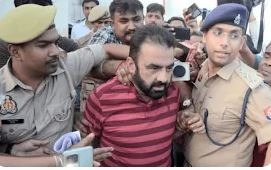Bareilly Unrest: 73 Arrested in 'I Love Muhammad' Protest Violence; Illegal Properties Demolished
Authorities in Bareilly have arrested 73 people linked to violent “I Love Muhammad” protests. In addition to the arrests, illegal constructions belonging to several accused individuals were sealed and demolished as part of the crackdown. The incident highlights ongoing tensions, the role of law enforcement, and the government’s zero-tolerance policy toward violence and unlawful property.


By: Bharat Daily Samachar Date: 1 October,2025
The Uttar Pradesh city of Bareilly witnessed high drama and tension after violent protests under the banner of the “I Love Muhammad” campaign turned chaotic. In the aftermath, police launched a widespread crackdown, arresting 73 individuals allegedly involved in stone-pelting, rioting, and incitement.
In addition to the arrests, the administration has taken tough action by sealing and demolishing illegal properties belonging to several of the accused. The move, officials said, was intended to send a strong message that violence and unlawful activity would not be tolerated.
How the Protests Escalated
The “I Love Muhammad” campaign, initially presented as a peaceful demonstration in Bareilly, quickly spiraled into unrest. According to police reports, large groups gathered in defiance of prohibitory orders, raising slogans and clashing with security personnel.
What began as a symbolic show of religious solidarity soon escalated into violent confrontations, with reports of stone-pelting, blocked roads, and damage to public property. Law enforcement rushed reinforcements to the scene to bring the situation under control. Several officers sustained minor injuries during the clashes.
Police Crackdown: 73 Arrested
Following the violence, Bareilly police identified and rounded up dozens of suspects. A total of 73 arrests have been made so far, including alleged instigators, repeat offenders, and those caught on video participating in the riots.
Senior police officials confirmed that further investigations are underway to track down more individuals linked to the violence. Surveillance footage, social media activity, and eyewitness accounts are being examined to build cases against the accused.
The arrests were made under charges of rioting, unlawful assembly, damage to public property, and disrupting peace. Authorities stressed that anyone proven guilty would face strict legal consequences.
Demolition of Illegal Properties
In a parallel action, Bareilly’s district administration began sealing and demolishing illegal constructions belonging to some of the accused. The move is part of the state’s broader policy of dealing with rioters by targeting illegally built assets that violate zoning and land-use laws.
Bulldozers rolled into several localities, bringing down unauthorized extensions, shops, and houses allegedly linked to those arrested. Officials defended the action, stating that these properties had already been flagged as illegal before the protests, but enforcement was delayed until now.
The demolitions have sparked debates, with supporters praising the government’s hardline stance against rioters, while critics accuse authorities of acting punitively.
Political and Social Reactions
The crackdown has triggered mixed reactions from different quarters.
Supporters of the government argue that such decisive action is necessary to maintain law and order and discourage future violence. They say illegal properties should not be spared if they belong to those who participate in unrest.
Critics and opposition leaders, however, question whether demolitions are legally justified, warning against collective punishment and the potential misuse of administrative power.
On the ground, local residents remain divided. While many express relief that order has been restored, others fear the consequences of aggressive enforcement measures.
Maintaining Peace and Security
Following the unrest, Bareilly police have increased their presence in sensitive areas. Patrolling has been stepped up, and prohibitory orders under Section 144 (which restricts unlawful gatherings) remain in place to prevent further flare-ups.
Senior officials have appealed to the public to remain calm and avoid spreading rumours on social media. They emphasized that freedom of expression must remain peaceful and within the framework of law, warning that incitement to violence would face immediate action.
Wider Implications for Uttar Pradesh
This incident is not isolated. In recent months, Uttar Pradesh has witnessed similar patterns: protests over religious or social issues occasionally escalating into clashes, followed by strict police action and demolition drives against those accused.
The government has made it clear that it will not tolerate violence, no matter the cause. However, this approach has also attracted scrutiny from civil rights groups, who argue that demolitions may bypass due legal processes.
For Bareilly, the unrest serves as a reminder of the delicate balance between safeguarding public order and respecting democratic rights.
Lessons From the Unrest
The Bareilly protests highlight several critical points:
Peaceful intent can be derailed quickly if not managed responsibly by both participants and authorities.
Social media and crowd dynamics can fuel rapid escalation, making it harder for law enforcement to intervene early.
Swift, visible action by the administration—such as arrests and demolitions—may deter future unrest, but also raises questions about fairness and proportionality.
Experts stress the need for community engagement, dialogue, and education to prevent such incidents in the future. Maintaining peace requires both enforcement and trust-building between communities and authorities.
Final Thoughts
The events in Bareilly underscore the challenges India faces in managing large-scale public demonstrations, especially when they are tied to religious sentiments. With 73 arrests and illegal properties demolished, the government has reinforced its zero-tolerance approach to violence.
Yet, the broader question remains: how can authorities ensure that genuine expressions of faith and opinion remain peaceful, without being hijacked by miscreants?
As Bareilly returns to calm, the incident serves as a reminder that peace is fragile and must be preserved through responsibility, dialogue, and rule of law.
